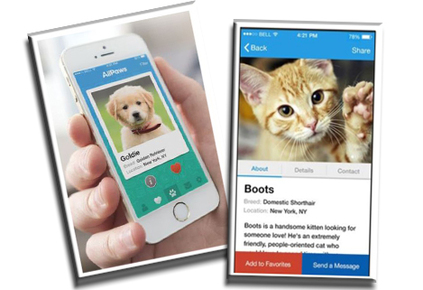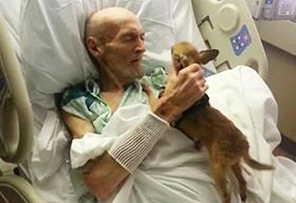|
What Makes Chocolate Toxic to Dogs Chocolate contains substances known as methylxanthines (specifically caffeine and theobromine), which dogs are far more sensitive to than people. Different types of chocolate contain varying amounts of methylxanthines. In general, though, the darker and more bitter the chocolate the greater the danger. For instance, 8 ounces (a ½ pound) of milk chocolate may sicken a 50-pound dog, whereas a dog of the same size can be poisoned by as little as 1 ounce of Baker's chocolate! Why Isn't Chocolate Toxic to Humans? Humans can break down and excrete methylxanthines such as theobromine much more efficiently than dogs. What Should I Do if My Dog Ate Chocolate? If you know your dog has ingested chocolate , or has any of the symptoms below, contact the Pet Poison Helpline at 1-855-213-6680 or your veterinarian right away. Remember, with any poisoning, it’s always cheaper, less invasive, and has a better prognosis/outcome if you treat early. Once your dog has already developed clinical signs and is affected by the poison, it makes for a much more expensive veterinary visit! Symptoms of concern include:
0 Comments
The Lhasa Apso is a small companion dog first developed in Tibet. Its lion-like appearance and bold personality make it a lovable addition to many families today.
PHYSICAL CHARACTERISTICS Not generally thought of as a great athlete, the Lhasa Apso does have well-developed thighs and quarters, a long body, and a strong loin and haunch. Its coat, which can be seen in a variety of cuts and colors, is coarse, heavy, straight, and long. Its darker tipped whiskers and beard, meanwhile, lend a stately, almost lion-like appearance to the dog. Many Lhasa Apsos also have a slight under bite. PERSONALITY AND TEMPERAMENT Despite its appearance, the Lhasa Apso is a tough dog -- bold, independent, stubborn and reserved towards strangers. The dog, however, is lovable towards its owner and makes for a great companion. CARE The Lhasa Apso's long coat requires combing and brushing every other day. It loves short walks and outdoor play sessions, but should not be kept outside. HEALTH The Lhasa Apso, which has an average lifespan of approximately 12 to 14 years, is susceptible to major health conditions like patellar luxation and minor aliments like progressive retinal atrophy (PRA), distichiasis, renal cortical hypoplasia, and entropion. To identify some of these issues, a veterinarian may run hip, knee, and eye exams on the dog. HISTORY AND BACKGROUND Although the Lhasa Apso’s exact origin is unknown, it is believed to be an ancient dog breed. Once considered an integral part of Tibetan monasteries and villages, the Lhasa Apso was thought to incorporate the souls of reincarnated Buddhist Lamas after their death. The Lhasa Apso also functioned as a monastery watchdog, alerting monks of incoming visitors, and was thus named Abso Seng Kye or "Bark Lion Sentinel Dog." Some theorize the breed may have derived its Western name, Lhasa Apso, because of its goat-like coat and from the corrupted form of the Tibetan word rapso, which means goat. When it was first introduced to England, the breed was referred to as the Lhasa Terrier, though it was not a real terrier. The original American Lhasa Apsos arrived in 1930, a gift from Thubten Gyatso, the 13th Dalai Lama, to C. Suydam Cutting, a wealthy American naturalist. In 1935, the Lhasa Apso was put under the American Kennel Club Terrier Group, but in 1959, it was transferred to the Non-Sporting Group. Today, the breed is a popular pet and show dog; a Lhasa Apso, Homero del Alcazar, even became World Champion at the World Dog Show in 2005.  Looking for love online has never been easier. With advancements in technology, getting hooked up with your perfect match is as simple as swiping a finger on your smartphone or tablet. But we’re not talking about finding your next hookup on Tinder or sorting through your connections on Match.com. We’re talking about discovering the adoptable pet of your dreams on the new iPhone app from AllPaws. AllPaws.com, a growing pet adoption website, announced the launch of its new, easy-to-use app that allows iPhone users to search and view photos of more than 200,000 dogs and cats available for adoption from shelters nationwide. On the new adoption app, users can view detailed pet profiles and photos, choose from multiple search filters, save searches, add pets to a “favorites” list and contact shelters directly from the mobile platform. Users can also help pets get adopted by sharing photos and pet profiles via social media websites including Facebook and Twitter. “AllPaws.com is already a best in class product on the Web, as hundreds of thousands of people each month have embraced our online dating style approach to pet adoption, and we’re extremely excited to expand our offering through the launch of a fun and engaging app for iPhone users,” said Founder and President Darrell Lerner. “We have created an app that is fun to play with while simultaneously providing the functionality to actually help users find a new pet to adopt,” added Kimberly Bouton, who worked as the product lead on the new offering. “The AllPaws iPhone app makes the process of finding a new pet easier than ever.” The free app is now available in the Apple Store. Miniature animals are nothing new such as Miniature horses. But mini cows? How does that even happen?
Turns out, there’s really no secret behind mini cows. They have been developed in the same way horse breeders developed the miniature horse: primarily through select breeding. Mini cow breeders will take their desired “regular size” breed, like the lovely red and white splotched beef breed the Hereford for example, and cross it with a Dexter, a cattle breed known for its particularly small stature. The resulting progeny will hopefully have the coloring of a Hereford and the size of a Dexter. Then with subsequent generations, breeders will select the animals that are the smallest, honing in the gene pool for size specificity. Eventually you’ll get cattle roughly 36 to 42 inches in height and voila: mini cows! Other than the sheer uniqueness of a mini cow, you might wonder why anyone would actually have one. Truthfully, many folks have minis as pets — they make efficient grass cutters that require less hay in the winter and less space in terms of housing. They also tend to be somewhat docile in nature, which I think corresponds to their size — they are handled more because they are small and therefore are tamer than perhaps your larger bovine. Some breeds of mini cow are actually endangered and some people are attracted to the preservation of a unique breed. Because of their small size, mini cows are easier to keep than larger bovines and thus can attract small-time hobby farmers. Exhibitions at shows and farm events are popular places to see mini cows and gives breeders a chance to educate the public. Many pet owners are hiding something – and that includes me! A recent survey states that nearly 80% of pet owners admit to masking pet stains in their homes due to ineffective and costly stain remedies. I have to admit that even I move furniture, cover rugs and couch pillows, hide dog toys and spray air freshener before my guests arrive.
The Woolite Carpet & Upholstery survey reveals the lengths people go to mask their pet’s stains. They found that 33% flip cushions, 23% rearrange furniture, 23% cover furniture, 20% entertain guests and visitors in other parts of the home and 8% dim the lights. In addition to these techniques, 63% of pet owners say they have given up on cleaning the stains altogether and have instead replaced the items their pets’ messes have ruined, with 40 percent spending more than $100 in the past year. I’m constantly cleaning up after a house full of active boys and a circus of furry pets. While I adore my Beagle mutt mixes and my Tortoiseshell and Tabby cats, I don’t always love their messes, especially when they leave unsightly stains and strong odors. We have carpet upstairs and hardwood floors downstairs. I can’t tell you how many times my kids declare, “Mom, Monkey threw up another hairball in my room!” Or while watching TV I hear them say, “Gross! Snoopy is on the couch with muddy paws.” I’m living proof that five sweet animals do indeed lounge, play and mess up my home. Here are a few key tips that will help you keep your home clean while minimizing the bacteria on soft surfaces. Choose washable and synthetic fabrics for your seating and bedding areas Denim, leather, micro-fiber or nylon are super easy to clean and pet hair tends to wipe off easily. Weekly pet washing with pet shampoo I know it can be a pain and time consuming, but washing your pet can minimize dirt and bacteria from their coats. If you have an outdoor cat you can wet-wipe him with a warm washcloth. For your pooch, you can do it the old fashioned way with a tub outdoors or with the hose if it’s warm out. Give your pup or kitty her own blankie that matches your home and bedroom décor All our bedrooms have nice micro-fleece blankets in bold colors at the end of all our beds. When guests visit they can’t tell that the perfectly folded blanket draped fashionably across the bed is actually Bailey, the kitten’s blanket! Once a week I toss it in the washer on the hot/sanitize setting to keep it fresh and clean. Have a No-Shoes-Rule in the house We can’t blame the entire mess on the kids and pets now can we? Our shoes carry in pollen, dirt and bacteria as well. Having a no-shoe household greatly decreases indoor allergies and cuts down on some of the mess that shoes bring in. Use a handheld vacuum or one with a hose attachment The hardest areas to clean are the nooks and crannies in the couch corners and between the stair steps. A good handheld vacuum or a one with a long hose is great for getting the hidden particles that you can’t see. Most of the time I find a cat nail that’s been shed or Lego brick in those areas! Nonetheless it’s gross and all the soft surfaces need to be vacuumed frequently. Use Pet Stain & Odor Remover that also sanitizes I need an effective cleaner that does it all since Monkey is the senior cat in our home and often leaves a vomit-filled hairball for us weekly. I’ll do most anything to keep her healthy, keep my house clean and kill bacteria. I not only want to get rid of pet stains and odors, but also want to kill the bacteria from carpets and soft surfaces that my kids and pets sleep and play on. With the new Woolite Advanced Pet Stain & Odor Remover + Sanitize, it takes one minute to sanitize soft surfaces, like upholstery, pet beds, cushions, etc. and one hour to sanitize carpeted† surfaces, like nylon & polyester. No more excuses! Your home doesn’t need to be a bacteria haven. With a little bit more effort, the right pet-friendly fabrics, and with a lot of love, you too can keep a clean home. MADRID, Oct 16, 2014 (AFP) - A Spanish town is deploying citizen street patrols and actors dressed as detectives to combat an invasion of dog droppings.
Actors in Sherlock Holmes costumes will spend the next two weeks pressing the case for cleaner sidewalks in Getafe, on the outskirts of Madrid. Then patrols will take to the streets to report any poo-petrators to the real police. "Residents asked for this," said a spokeswoman for the mayor's office. A study in September, she said, showed an average of 7.8 pieces of dog excrement every 100 metres (yards). The operation, dubbed "Canine Watch," takes inspiration from a similar clean-up programme in Colmenar Viejo, to the north of Madrid. The association between Ebola and dogs has been all over the news lately. After potentially being exposed by their infected owners, a Spanish dog, Excalibur, was euthanized, while a Texas dog, Bentley, is being held in isolation at an undisclosed location. The disparate handling of these two cases raises the question — what risk do dogs really pose when it comes to the transmission of the Ebola virus?
We do know that Ebola has the ability to infect certain types of animals in addition to humans. Antibodies to the virus are widespread in African fruit bats. Many scientists think that fruit bats may be the natural hosts for Ebola since they do not appear to become sick from the virus, but they do shed it. Nonhuman primates react like people when infected with Ebola, becoming very sick and often dying. Forest antelope can also become infected. Researchers noted that during an Ebola outbreak in Gabon in 2001-2002, “unexplained deaths of animals had been mentioned in the nearby forests” and “samples taken from their carcasses [primates and antelopes] confirmed a concomitant animal epidemic.” Pigs can become infected with the “Reston” variant of Ebola, but this strain does not make people sick. Contact with fruit bats and/or wild animals hunted for food are the most likely initial sources of infection in human Ebola outbreaks. Ebola is a zoonotic disease (a disease that can be transmitted from animals to people) even though by far the most common route of transmission once an outbreak has started is person to person. All of this means that concerns about dogs living in close contact with Ebola victims are not unreasonable. In fact, research looking at the Gabon outbreak showed that approximately 25 percent of the dogs in the region had produced antibodies against the Ebola, indicating they had been exposed to the virus. This does not mean, however, that the dogs actually “had” Ebola or could transmit it to people or other animals. As the Centers for Disease Control says on its website, “At this time, there have been no reports of dogs or cats becoming sick with Ebola or of being able to spread Ebola to people or animals.” A few weeks ago, I spoke to Dr. Ronald Harty, associate professor of microbiology at Penn Vet, about his research into a potential drug to combat Ebola. I think he explains the situation best. As quoted in Delaware Online, The News Journal: “The dog's immune system reacted to the virus it came in contact with but did not replicate it," Harty said. That means the dog's body recognizes there was a threat present and created antibodies to fight it, but the virus didn't create more copies of itself and spread, as a viral infection does. "It is highly unlikely a dog, cat or any other domestic animal could contract or transmit the disease.” Because of this extremely low chance of disease transmission, the World Small Animal Veterinary Association recommends that, in cases like Excalibur’s and Bentley’s, dogs be quarantined and tested but not immediately euthanized. Kudos to the authorities in Dallas who let science rather than unfounded fear guide their decision making. Article By Dr. Coates References Ebola virus antibody prevalence in dogs and human risk. Allela L, Boury O, Pouillot R, Délicat A, Yaba P, Kumulungui B, Rouquet P, Gonzalez JP, Leroy EM. Emerg Infect Dis. 2005 Mar;11(3):385-90. Reston ebolavirus in humans and animals in the Philippines: a review. Miranda ME, Miranda NL. J Infect Dis. 2011 Nov;204 Suppl 3:S757-60. [Multiple Ebola virus haemorrhagic fever outbreaks in Gabon, from October 2001 to April 2002]. Nkoghe D, Formenty P, Leroy EM, Nnegue S, Edou SY, Ba JI, Allarangar Y, Cabore J, Bachy C, Andraghetti R, de Benoist AC, Galanis E, Rose A, Bausch D, Reynolds M, Rollin P, Choueibou C, Shongo R, Gergonne B, Koné LM, Yada A, Roth C, Mve MT. Bull Soc Pathol Exot. 2005 Sep;98(3):224-9. French. Eliminate the dangers of Halloween Halloween can be a festive and fun time for children and families, but what about for our pets? Yes, there are some adorable pet costumes to look forward to, but from constantly opening the door for trick-or-treaters to Halloween pranksters to all that candy lying around, there can be some hazards as well. Forgo any stressors or dangers this year by following these 10 easy tips. #10 Trick-or-treat candies are not for pets
All forms of chocolate - especially baking or dark chocolate - can be dangerous, and even lethal, for dogs and cats. Symptoms of chocolate poisoning may include vomiting, diarrhea, rapid breathing, increased heart rate, and seizures. Halloween candies containing the artificial sweetener xylitol can also be lethally poisonous to dogs. Even small amounts of xylitol can cause a sudden drop in blood sugar, subsequent loss of coordination, and seizures. #9 Don't leave pets out in the yard on Halloween Surprisingly, vicious pranksters have been known to tease, injure, steal, and even kill pets on Halloween night. Inexcusable? Yes! But preventable, nonetheless. Keep your pet indoors on Halloween night. #8 Keep pets confined and away from the door Not only will your door be constantly opening and closing on Halloween, but strangers will be dressed in unusual costumes and yelling loudly for their candy. This, of course, is scary for our furry friends, who don’t know the difference between fun yelling and aggressive yelling. Dogs can be territorial and may become anxious and growl at innocent trick-or-treaters. Putting your pets in a secure room away from the front door will protect the kids, and also prevent them from darting outside into the night. #7 Keep your black cats - or any cats - indoors around Halloween Any outdoor animals can become the targets of Halloween pranksters, but black cats are especially at risk. Black cats are sometimes associated with satanic rituals and sacrifices, and cruel or naïve people may harm black cats just because of their mythical association with the Halloween holiday. In fact, many shelters are known to uphold a no black cats adoption policy during the month of October as a safety precaution. #6 Keep Halloween plants, such as pumpkins and corn, out of reach While we might not think of taking a big bite out of the jack-o-lantern or dried corn, keep in mind that they are still food, and still smell yummy to a dog. Although they are relatively nontoxic, such plants can induce gastrointestinal upset should your pets (i.e., chow-hounds) ingest them in large quantities. A dangerous intestinal blockage can even occur if large pieces are swallowed. And speaking of pumpkins... #5 Don't keep lit pumpkins or any type of fire around pets Should they get too close to the lit candle, pets run the risk of burning themselves or even knocking the candle over and causing a fire. Instead, rely on flashlights and battery operated tea-light candles to bring a glow to your jack-o-lanterns. #4 Keep your decorations safe If decorating with electrical equipment, be sure to keep the wires out of the way so your pet doesn’t get to them. Wires from lights and other decorations, if chewed, will not only be ruined but could give your pet a possibly life-threatening electrical shock. #3 Consider your pet's feelings while costume shopping If you do decide that Fido or Kitty needs a costume, make sure it isn't annoying or unsafe. It should not constrict movement, hearing, breathing, or the ability to bark or meow. If your pet acts like he or she would rather eat the costume than wear it, it’s probably not a good idea. And always keep your outfitted pet under close supervision to prevent strangling, suffocation, or choking. #2 Try on pet costumes before the big night If your pet seems distressed, allergic, or shows any abnormal behavior while in costume, consider letting him or her go “au naturel.” Festive bandanas and ribbons can work just as well for party poopers, too. #1 IDs, Please! If your dog or cat should escape and become lost, having the proper identification will increase the chances that they will be returned. Microchips are great, but require a veterinarian with a scanner to locate the owner’s information. It is always best to use a collar with an ID tag – with up-to-date information – so that your pet can be returned most quickly.  Every pet lover knows and understands the bond between a dog and his human. It is an incredibly special connection that heals all wounds and lifts all spirits. And medical workers in a Kentucky hospital are experiencing that amazing, heartwarming love first-hand with one of their patients and his dog. According to The Dodo, James Wathern was admitted to Baptist Health Corbin a few weeks ago and the man’s condition continued to worsen over time. Wathern was near death and had stopped eating. But the dying man made one last request to the staff members at the facility — he wanted to see his dog. Despite the hospital’s no-pets policy, the workers rallied together and partnered with Know-Whitley Animal Shelter to track down Wathern’s dog, an aging, one-eyed Chihuahua named Bubba. Bubba was turned over to the shelter around the same time Wathern was admitted to the hospital. A foster family stepped up to take care of Bubba, and the shelter and the family agreed to help make Wathern’s wish come true. On October 11, staff members and volunteers brought Bubba to Wathern’s hospital bed and handed the small dog over to his faithful friend. According to the Knox-Whitley Animal Shelter Facebook page, Wathern started to cry as soon as he saw his dog again. Bubba snuggled up next to his companion and the two just began to enjoy their time together. A few days after the first visit, hospital workers saw a drastic improvement in Wathern’s condition. Chief nurse Kimberly Probus told reporters that Wathern has been more “lucid and engaged” since seeing his dog.  WASHINGTON - The pet dog of a Texas healthcare worker who was infected with Ebola while caring for a Liberian patient will not be killed, US officials said Monday. The American answer to the question of what to do with a dog whose owner gets Ebola contrasted starkly with what happened in Spain last week, when authorities there put down an infected nurse's dog. "The healthcare worker had a dog, and we want to make sure we respond appropriately," said David Lakey, commissioner of the Texas Department of State Health Services. "And so we are working hard to find a location to care for the dog and a location where we can have the proper monitoring of the dog." Dallas Mayor Mike Rawlings also told USA Today that the dog would be spared. "The dog's very important to the patient and we want it to be safe," he was quoted as saying. On Wednesday, Spanish authorities put down Excalibur, the pet dog of a nurse hospitalized with Ebola after she treated two missionaries who died of the disease in Madrid. The dog had been put to sleep "to avoid suffering," a statement from the Madrid regional government said. The decision sparked protests from animal rights groups, some of whom scuffled with police outside the apartment where the dog had been left by his owners when they were taken into quarantine. Experts say there is a risk that canines may carry the deadly virus, but no evidence that they could infect humans. More than 4,000 people have been killed by Ebola in West Africa since the beginning of the year. |
The PAW Blog...
For the LOVE of Pets The goal of this blog is to help educate pet owners by sharing pet health facts and pet news articles...and ... sometimes put a smile on your face with a cute or funny pet story! Categories
All
Archives
July 2024
Search for any topic...
|


 RSS Feed
RSS Feed

